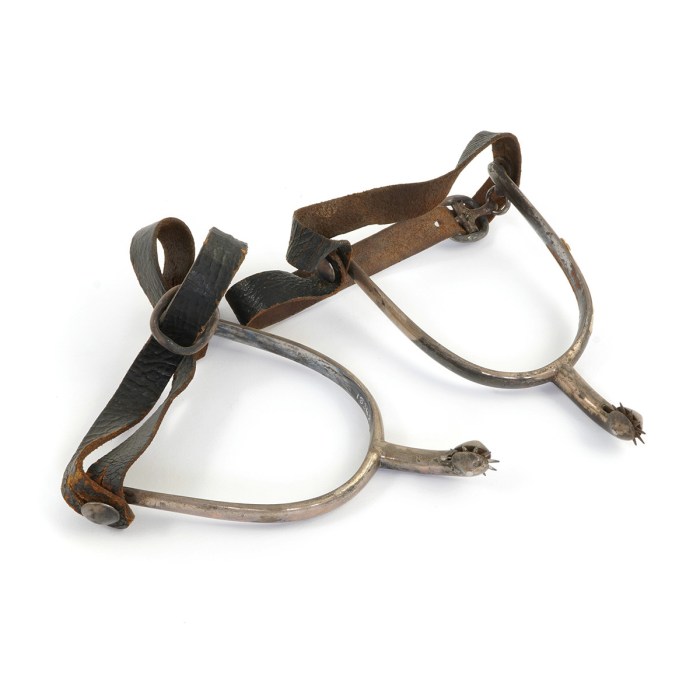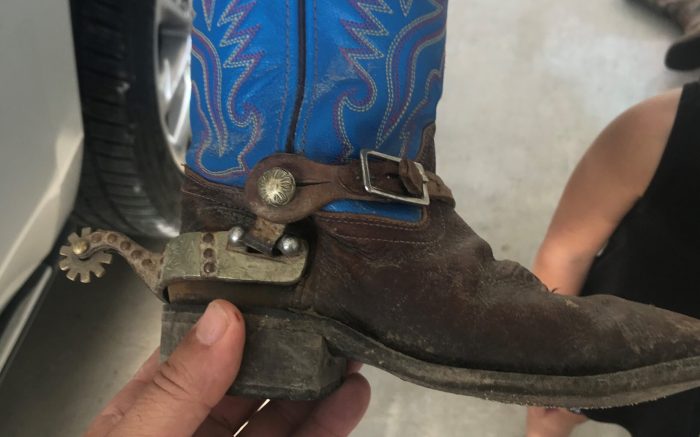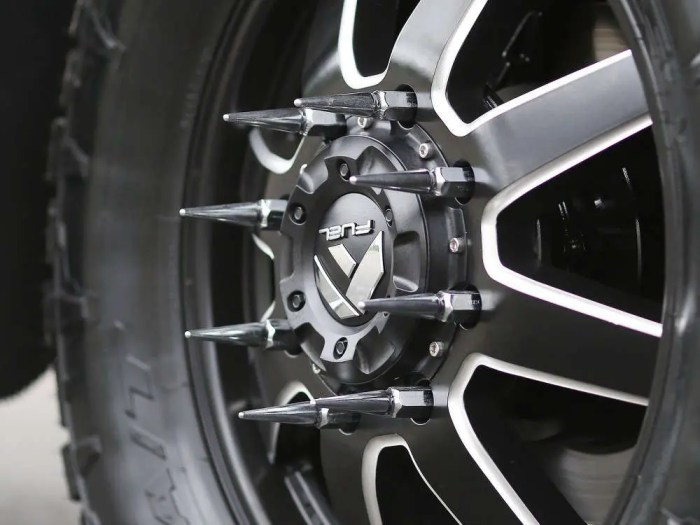The spiked wheel on a spur, a fascinating equestrian accessory, has a rich history and diverse applications. From its origins in ancient times to its modern-day use in equestrian sports, this unique device has played a significant role in shaping the relationship between humans and horses.
Throughout history, the spiked wheel on a spur has evolved in design and function, reflecting the changing needs and technologies of different cultures and time periods. Initially crafted from bone or wood, these wheels later incorporated metal spikes to enhance their traction and effectiveness.
History of the Spiked Wheel on a Spur

The spiked wheel on a spur has a rich history dating back centuries. Its origins can be traced to ancient civilizations, where it was used as a practical tool for enhancing traction and stability while riding horses.
Initially crafted from rudimentary materials such as wood and bone, spiked wheels gradually evolved with advancements in metallurgy. Iron and steel became the preferred choices due to their durability and ability to withstand the rigors of equestrian activities.
Spiked wheels on spurs, once a symbol of power and control, have evolved into a mere curiosity. But for those seeking a glimpse into the past, the nr 601 final exam 2023 offers a comprehensive review of their historical significance.
While the spiked wheel may no longer adorn the heels of modern-day riders, its legacy lives on in the annals of equestrian history.
Materials Used
Throughout history, various materials have been employed in the construction of spiked wheels, each offering unique advantages:
- Wood:The most basic material, wood was commonly used in early iterations of spiked wheels due to its accessibility and ease of shaping.
- Bone:Animal bones, particularly those from large animals like horses and cattle, provided a more durable option than wood, withstanding wear and tear better.
- Iron:The introduction of iron marked a significant advancement, as it offered greater strength and longevity compared to previous materials.
- Steel:The development of steel further enhanced the durability and performance of spiked wheels, making them more resistant to bending and breakage.
Usage Across Cultures and Time Periods
Spiked wheels have been widely used in various cultures and time periods, each with its own distinct purpose and design:
- Ancient Greece:Greek cavalrymen used spiked wheels to provide additional traction during maneuvers and battles.
- Medieval Europe:Knights relied on spiked wheels for stability while jousting and engaging in combat.
- Native American Plains:Native American tribes employed spiked wheels for enhanced grip on the open prairies.
- Modern Equestrianism:In contemporary equestrian sports, spiked wheels continue to be used for traction and control in disciplines such as show jumping and cross-country.
Design and Function of the Spiked Wheel on a Spur

A spiked wheel on a spur is a device that enhances traction and stability for riders on horseback. It typically consists of a wheel with a series of spikes or studs protruding from its rim.
The spikes on the wheel interact with the ground, digging into the soil or other surfaces to provide additional grip. This improved traction allows riders to maintain control of their horses in slippery or uneven terrain, making it particularly useful for activities such as cross-country riding and steep mountain trails.
Advantages of Spiked Wheels
- Enhanced traction on slippery or uneven surfaces
- Increased stability for riders
- Improved control in challenging terrain
Disadvantages of Spiked Wheels
- Can be noisy on hard surfaces
- May damage soft or delicate surfaces
- Requires maintenance and occasional replacement of spikes
Uses of the Spiked Wheel on a Spur

The spiked wheel on a spur serves multiple purposes, enhancing the rider’s control and stability in various equestrian activities.
Riding
In riding, the spiked wheel provides additional grip against the horse’s side, allowing the rider to maintain a secure and balanced position. The wheel’s spikes dig into the horse’s coat, creating friction that prevents the rider’s foot from slipping, particularly during turns or when the horse is moving quickly.
Hunting, Spiked wheel on a spur
Spiked wheels are also used in hunting, where they assist riders in controlling their horses during the chase. The spikes help the rider stay firmly in the saddle, even when navigating rough terrain or pursuing fast-moving game.
Combat
Historically, spiked wheels on spurs were employed in combat to inflict damage upon opponents. The spikes could pierce armor or flesh, increasing the rider’s effectiveness in close-quarters engagements.
Safety Considerations
While spiked wheels on spurs offer several advantages, it is crucial to consider safety precautions. The spikes can potentially cause injury to the horse if used improperly or excessively. Riders must be mindful of the force and placement of their spurs to avoid harming their mounts.
Spiked wheels on spurs are designed to dig into a horse’s side and encourage it to move forward. Similarly, the game obey me cheating on mc can also be seen as a form of encouragement, albeit a more controversial one.
Just as the spiked wheel can cause discomfort to the horse, the game’s plotline can also cause discomfort to players who feel betrayed by the characters they love. Ultimately, both the spiked wheel and the game serve as reminders that even the most trusted individuals can sometimes let us down.
Cultural Significance of the Spiked Wheel on a Spur

The spiked wheel on a spur has played a significant role in various cultures, often symbolizing power, authority, and status. In ancient times, the spiked wheel was associated with equestrian warriors, who used it to enhance their control over their horses and increase their combat effectiveness.
Symbol of Power and Authority
In many societies, the spiked wheel on a spur was a symbol of power and authority. In medieval Europe, knights and nobles wore spurs adorned with spiked wheels as a sign of their status and rank. The spikes were believed to give the wearer an advantage in battle by providing additional grip and control over their horses.
Spiked wheels on a spur are not as common as they used to be, but they can still be found on some older models. If you’re interested in learning more about this topic, you can take the raisin in the sun quiz . This quiz will test your knowledge of the play and its characters.
After you’ve taken the quiz, you can come back and learn more about spiked wheels on a spur.
Role in Traditional Ceremonies and Rituals
The spiked wheel on a spur has also been used in traditional ceremonies and rituals. In some cultures, spurs were presented to young men as a symbol of their transition to adulthood. In other cultures, spurs were used in religious ceremonies to represent the power and authority of the deity being worshipped.
Modern Applications of the Spiked Wheel on a Spur

The spiked wheel on a spur has evolved from its traditional equestrian roots to find applications in modern settings. In equestrian sports, spiked spurs are still used to provide additional control and precision in riding, particularly in disciplines such as dressage and show jumping.
To meet the needs of modern riders, the design of spiked spurs has been adapted. Materials like stainless steel and titanium are now commonly used, offering durability and resistance to corrosion. Spur rowels, the rotating wheels with spikes, are also available in various sizes and configurations to suit different riding styles and preferences.
Reenactments and Historical Displays
Spiked spurs also play a significant role in historical reenactments and displays. They are used by enthusiasts and actors to recreate the appearance and equipment of knights, cavalrymen, and other historical figures. The spiked wheel on a spur adds an authentic touch to these performances, evoking the spirit of past eras.
Future Prospects
The future of the spiked wheel on a spur looks promising. In equestrian sports, it is expected to continue being a valuable tool for riders seeking greater control and finesse. In reenactments and historical displays, its role as an authenticating element is likely to remain strong.
Additionally, the spiked wheel may find new applications in fields such as theatrical productions and costume design.
Frequently Asked Questions
What is the primary purpose of a spiked wheel on a spur?
To enhance the rider’s control and stability by providing additional traction on the horse’s side.
When were spiked wheels on spurs first used?
Their origins can be traced back to ancient times, with evidence of their use in various cultures.
Are spiked wheels on spurs safe to use?
Yes, when used properly and with appropriate training. However, riders should be aware of potential safety considerations and use them responsibly.